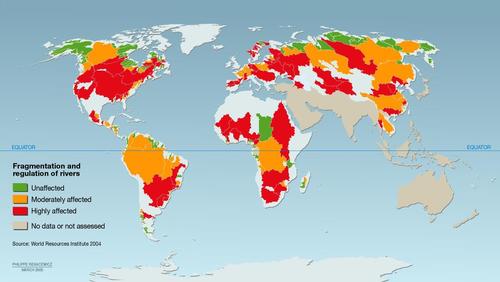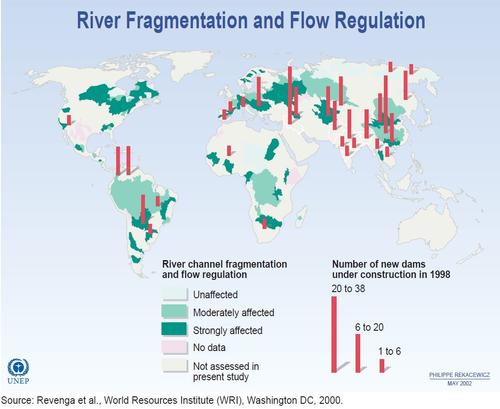River fragmentation and flow regulation
Natural rivers and their riparian zones are part of the most diverse, dynamic and complex ecosystems in the world. Therefore river fragmentation and flow regulation are the most common and widespread impacts of humankind on the natural environment. (Dynesius & Nilsson 1994)
River fragmentation, which is the interruption of a river’s natural flow by dams, inter-basin transfers, or water withdrawal, is an indicator of the degree that rivers have been modified by humans (Revenga et al. 2000). In Revenga et al. 2000, the results of two studies were combined to give an overview about the fragmentation of the 227 major river basins in the world. The analysis indicates that:
- 37% (84 rivers) were strongly affected (less than one quarter of their main channel left without dams, the largest tributary has at least one dam and annual flow patterns have changed substantially)
- 23% (52 rivers) were moderately affected
- 40% (91 rivers) were unaffected (without dams in the main channel and, if tributaries have been dammed, river discharge has declined or been contained in reservoirs by no more than 2 percent)
- Strongly or moderately fragmented systems accounted for nearly 90% of the total water volume flowing through the rivers analyzed
- In the developing world, large dams are still being built at a fast rate, threatening the integrity of some of the remaining free flowing rivers in the world.
Nilsson et al. 2005 give a global overview of dam-based impacts on large river systems by continents. Large river systems (LRS) are defined as rivers with a virgin mean annual discharge (VMAD) equal to or above 350 m³ per second. The study indicates that:
- 172 out of 292 LRS (over 58%) are affected by dams including the eight most biogeographically diverse
- In North & Central America 80%, in Asia 90%, in Europe 92%, in South America 94%, in Africa 88% and in Australia 72% of the area covered by these LRS are moderately and strongly affected
- There are >45,000 dams above 15 m high, capable of holding back >6500 km³ of water (or about 15% of the total annual river runoff globally)
The impacts of dams on ecosystems like anoxia, greenhouse gas emission, sedimentation and an upsurge of nutrient release are generally well known. In free-flowing rivers, biodiversity can persist because organism dispersal can be effective in both upstream and downstream directions and because many organisms are likely to adapt to climate change by concomitant shifts in distributions. However, in fragmented and regulated rivers such dispersal can be strongly limited. These facts need to be considered in global planning for sustainable river management. (Nilsson et al. 2005)

